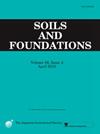负温条件下淤泥动态特性参数的实验研究与修正
IF 3.3
2区 工程技术
Q2 ENGINEERING, GEOLOGICAL
引用次数: 0
摘要
为了研究不同负温条件下阻尼比、动模量和冻土骨架曲线等动力特性参数的变化原理,研究选取了长春地区的淤泥质粘土。使用温控 GDS 动态三轴仪对不同负温条件下的淤泥质粘土进行了动态加载研究。结果表明,温度越低,实现相同动应变所需的动应力越大。动态模量 1/Ed 的倒数与动态应变成线性关系,1/Ed 倒数的拟合线截距随温度降低而减小。阻尼比和吸收振动波的能力随着温度的降低而降低。随着温度的降低,最大动态模量逐渐增大,而最大阻尼比的趋势则相反。根据试验数据,采用相关分析方法提出了淤泥质粘土最大动模量和最大阻尼比的温度修正公式。本文章由计算机程序翻译,如有差异,请以英文原文为准。
Experimental study and correction of dynamic characteristic parameters of silty clay under negative temperature conditions
In order to examine the principles governing the variation of dynamic characteristic parameters, including the damping ratio, dynamic modulus, and frozen soil backbone curve, under different negative temperature conditions, silty clays sourced from the Changchun region were selected for the research. Dynamic loading studies were carried out on silty clays under different negative temperature conditions using a temperature-controlled GDS dynamic triaxial machine. The results demonstrated that the lower the temperature, the higher the dynamic stress required to achieve the same dynamic strain. The inverse of the dynamic modulus is linearly related to the dynamic strain, and the intercept of the fitted line of the inverse of decreases with decreasing temperature. The damping ratio and ability to absorb vibration waves decrease as the temperature drops. As the temperature decreases, the maximum dynamic modulus gradually increases, and the maximum damping ratio has the opposite trend. The temperature correction formulas for the maximum dynamic modulus and maximum damping ratio of silty clay are proposed by correlation analysis method based on test data.
求助全文
通过发布文献求助,成功后即可免费获取论文全文。
去求助
来源期刊

Soils and Foundations
工程技术-地球科学综合
CiteScore
6.40
自引率
8.10%
发文量
99
审稿时长
5 months
期刊介绍:
Soils and Foundations is one of the leading journals in the field of soil mechanics and geotechnical engineering. It is the official journal of the Japanese Geotechnical Society (JGS)., The journal publishes a variety of original research paper, technical reports, technical notes, as well as the state-of-the-art reports upon invitation by the Editor, in the fields of soil and rock mechanics, geotechnical engineering, and environmental geotechnics. Since the publication of Volume 1, No.1 issue in June 1960, Soils and Foundations will celebrate the 60th anniversary in the year of 2020.
Soils and Foundations welcomes theoretical as well as practical work associated with the aforementioned field(s). Case studies that describe the original and interdisciplinary work applicable to geotechnical engineering are particularly encouraged. Discussions to each of the published articles are also welcomed in order to provide an avenue in which opinions of peers may be fed back or exchanged. In providing latest expertise on a specific topic, one issue out of six per year on average was allocated to include selected papers from the International Symposia which were held in Japan as well as overseas.
 求助内容:
求助内容: 应助结果提醒方式:
应助结果提醒方式:


